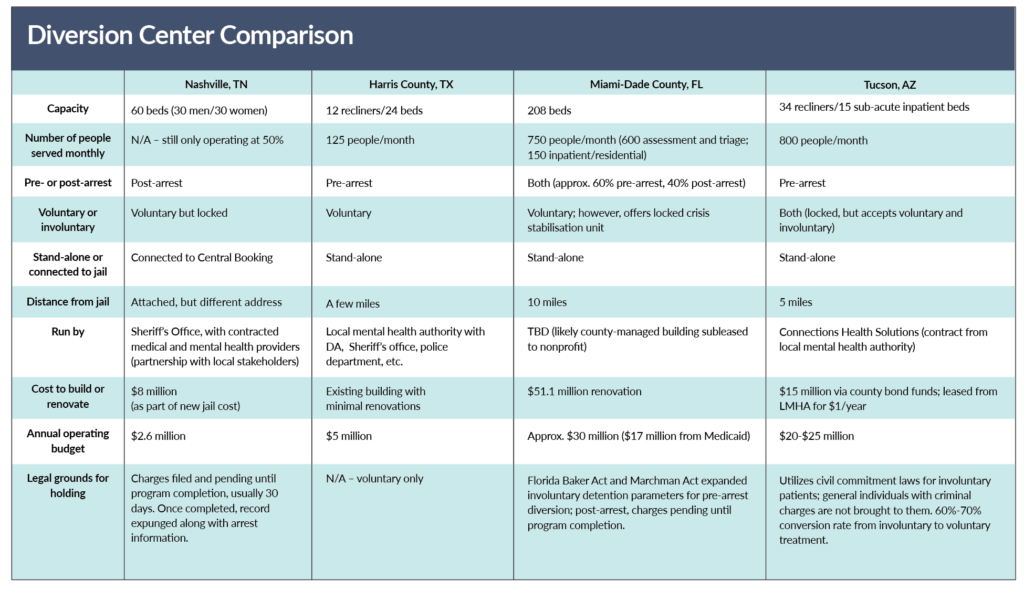This is the third in a series of seven articles about the Travis County Forensic Mental Health Project. This series of articles was named the Best Series of Articles – General Interest by the State Bar of Texas‘ Division III Stars of Texas Bars Awards.
The Travis County Forensic Mental Health Project delivered its recommendations to the Travis County Commissioners in March 2023. The goal of these recommendations is to provide solutions other than jail to address mental health and substance abuse disorders in the county.
Recommendation #2
The report’s second recommendation is the construction of a Travis County diversion center “designed to co-locate functions and services to create a platform to support individuals in the mental health/criminal/legal intersection to avoid jail whenever possible and receive mental health disorder care, while also supporting community safety.”
This diversion center would include clinical evaluations; psychiatric and medical treatment, including substance abuse treatment; legal support when required; and community reentry services.
“Integrating legal support within the center could create collaborative approaches for people whose mental health disorder led to being detained by the police and charges are not dismissed,” the recommendation document says.
The biggest challenge for this recommendation, the document states, is estimating the optimal size to meet current and future need. This challenge results from “inadequate records and information to identify the number of individuals within a specified time who might be referred into a diversion center.”
The Project ultimately arrived at a current need of up to 70 beds, while in the next decade this amount would need to increase to up to 88 beds.
“We started with the average number of people released from jail monthly—about 400 people,” the document explains. “We assumed that 40 percent of individuals receive mental health services while in jail, resulting in 160 a month with a mental health disorder need. Not all will qualify for diversion, resulting in a ‘best-estimate’ need to ‘divert’ 100 people per month.”
The Project estimated that approximately 64 individuals would qualify for diversion monthly. They based their calculations on “fragmented” Travis County data, identifying 2,231 individuals with an identified mental health flag in the Travis County Central Booking and jail database. Of these, 106 people, each with between three and 89 arrests, “typified people cycling in and out of jail.” Seventy-five percent of these arrests were for misdemeanors. Of all the identified misdemeanors, criminal trespassing represented the largest amount of arrests, at 55 percent.
“Had alternative interventions been in place, many of these individuals might have received care for their mental health disorder in a therapeutic and less restrictive setting than jail,” the document says.
Ultimately, the Project estimates the current need for the amount of beds at the proposed diversion center would range between 32 and 70. Over the next 10 years, this range would increase by 25 percent, to between 40 and 88 beds, presuming increases in county population are similar to the last decade.
“Critical to these assumptions is that the length of stay is managed at two weeks or less, requiring sufficient investment in outpatient care and housing options to provide an exit from the center,” the document says. “If the center is established without adequate exit opportunities, it will quickly devolve into, effectively, a jail or state hospital, or it will simply be releasing people back to the streets to cycle back through the system.”
The Project did not provide an estimated timeframe on the construction of a diversion center, saying it would be “dependent on court’s direction.” The Project did estimate the construction cost of a 32-bed facility at $30.7 million, with an annual budget of $5.4 million.
Recognizing the high cost, the Project recommended repurposing an existing facility while the new diversion center is being built. The Project suggested both Travis County’s Judge Guy Herman Center for Mental Health Crisis Care and the Travis County Adult Probation SMART program’s facility.
“Both would provide time to strategically design, implement, and build a new center while piloting a program and allow operational testing and improvements throughout the system,” the document says.
While the Project did not provide any recommendations on where funding for the construction of a new diversion center would come from, it did offer a recommendation on funding the annual operating budget.
Under current law, treatment provided to adults in an institution for mental diseases with more than 16 beds is not reimbursable under Medicaid. This payment prohibition is known as the Medicaid Institution for Mental Diseases (“IMD”) exclusion.1
“If Medicaid revenue is needed as a substantial support of operating expenses … Travis County might consider building two to three independent diversion centers with 16-bed capacity,” the document says. “This approach might allow easier expansion with county growth over time, although almost certainly is less cost-efficient to operate.”
The Project recommended not locking into one option during the planning and design phases.
“A key aspect of a diversion center is providing enough time for an individual to stabilize and receive referrals for connections in the community,” the document says. “There are several legal mechanisms used by other diversion centers to hold individuals, who may not want to remain for the duration needed, while this work is completed.”
The first of these mechanisms, used by a diversion center in Nashville, Tenn., is to file charges against the person and then dismiss or expunge the records once treatment is completed.

“A second mechanism is to use existing emergency detention laws to their fullest extent or create new parameters which allow for involuntary treatment for a longer period of time,” the document says, adding that “the current Texas statute allows for up to 30 days.”
Currently, Section 574.034 of the Texas Health & Safety Code says, “An order for temporary inpatient mental health services shall provide for a period of treatment not to exceed 45 days, except that the order may specify a period not to exceed 90 days if the judge finds that the longer period is necessary.”3
The document says a diversion center in Harris County treats 125 people a month on a voluntary basis, including in lieu of additional legal processes. These individuals are free to leave at any time.
Other features of the Harris County diversion center include:
• Has 12 recliners/24 beds
• Provides pre-arrest support
• Provides only voluntary treatment
• Is a stand-alone facility not connected to a jail
• Is a few miles from the nearest jail
• Is run by a local mental health authority and a committee made up of representatives of the Harris Center for Mental Health and Intellectual/Developmental Disorders, the Harris County District Attorney’s Office, the Harris County Sheriff’s Office, the Harris County Budget Office, the Harris County Public Defender’s Office, the Harris County Community Supervision and Corrections Department, and the Houston Police Department
• Was established within an existing building with minimal renovations
• Costs $5 million annually to operate
Contrasting this is a diversion center in Tucson, AZ: “Tucson had success in building relationships with individuals originally brought in involuntarily and then transitioning them to voluntary treatment, which is commonly done in many private psychiatric facilities,” the document says.
The Project recommends the proposed Travis County diversion center offer both pre-arrest and post-arrest support.
“Doing so provides a maximum number of exit points from the legal system into better community-supported treatment and residential opportunities,” the document says.
No ideal diversion-center model has been established, the document notes. A successful and efficient system of care should be anchored in, but not exclusively reliant upon, a diversion center.
“Most successes for counties with diversion centers come not from the center itself, but from the implementation of wide-ranging, widely available mental health treatment and programs,” the document says.
A diversion center is currently being built in Miami-Dade County, Fla. Despite this, crisis intervention teams (CITs) decreased arrest rates and the number of individuals referred to emergency departments.
“The Miami-Dade CIT was able to divert enough arrests that they successfully closed one of their jails, saving roughly $12 million annually in taxpayer dollars,” the document says. “Between 2010-2018, their CIT had an arrest rate of .002 percent, decreasing the inmate population by 39 percent. They estimate this resulted in roughly 109,704 fewer inmate jail days annually, which is a cost avoidance of $29 million per year.”
ENDNOTES
1 “Medicaid Emergency Psychiatric Demonstration: Demonstration Design and Solicitation.” Centers for Medicare & Medicaid Services. Accessed May 25, 2023. https://innovation.cms.gov/files/x/medicaidemerpsy_solicitation.pdf

